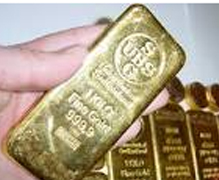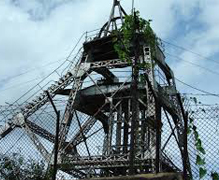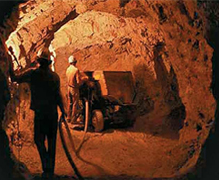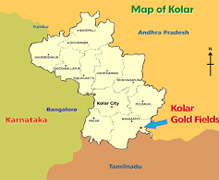

The Beginnings
Gold was first mined in the area around Kolar in the 2nd and 3rd century AD by the digging of small pits. During the Chola period in the 9th and 10th century AD the scale of the operation grew, but large-scale mining only came in the 1850s under the British with more manpower and sophisticated machinery. In that year 1873 Mr. M.F. Lavelle, a resident in Bangalore, retired from the army, with some knowledge of geology, applied to the Government for the exclusive privilege of mining in the Kolar District, his thoughts being principally directed to the possibility of finding coal. His request was granted on certain terms. On these conditions, Mr. Lavelle commenced operations by sinking a shaft in 1875, near Oorgaum. But finding that large capital would be required for carrying out the work, he next year, with the approval of Government, transferred all his rights and concessions to Colonel Beresford. This officer, with some friends among racing men, formed a syndicate known as the Kolar Concessionaires, who took up the matter in earnest.
The Remains
The remains after extracting gold piled up to form a barren hill near the mines. At some places, the stones are loose and there is a high chance of losing grips while climbing. The hill is about 30 meters high and can be seen to the north from the Robertsonpet town. From the top of the hill you can see a good view of the town and the mines far away. The hill was mostly made up of some soft stone, probably hardened due to the heavy pressure of the soil on top, there were many interesting patterns on the rocks.
The Hill was strong enough. No trees or plants were growing on the hills. At a few sides, the stones are loose and there is a high chance of loosing grips while climbing. The hill was about 30 meters high. The hill can be seen to the north from the Robertsonpet town. From the top of the hill you can see a good view of the town and the mines far away. The hill was mostly made up of some soft stone, probably hardened due to the heavy pressure of the soil on top, there were many interesting patterns on the rocks.
The reduction of gold deposits and Increase in the cost of production forced the KGF to be closed by 2003. Now all the remains are left as ruins. Instruments and machines worth millions are just left to the dance of wind and rains. There are a few military officers to guard it, they can keep the monument away from the forces of nature. It is believed that an earthquake which occurred nearby is due to the presence of this mine.
The Mining and Improvements
The Golden Carpets were 4 miles (6 km) long with an average width of 4 miles, were first worked by a British company, John Taylor and Sons, in 1880. Within three years, four main veins (Champion, Oorgaum, Nundydorog, and Mysore) were opened. Champion, the deepest, reached some 10,500 feet (3,200 meters) below sea level.
Until the year 1902 all the machinery in the Mines was worked by steam power, but in August 1902 the completion of the Cauvery Power Works, brought about a complete revolution in the working of most of the Mines on the Fields, whereby 4000 H.P. of electric energy is transmitted to the Gold Fields from the Cauvery Falls Power Station received at an elaborate Transformer House centrally situated and distributed to the various mines in quantities contracted for and by the means of this electric power the majority of the mines work their milling and stamping machinery.
Kolar Gold Fields was the first city in Asia to get Electricity from Shivanasamudra (A waterfall near Kanakapura, Bangalore) in Mysore. People from as far as Kolar could see the lights of this once prosperous city. KGF was known as "Little England " by the British, due to its more temperate Weather and a landscape more similar to Britain`s. It also had a sizable Anglo-Indian Population who worked in the various mines in different capacities.. Silicosis, a form of pneumoconiosis caused by inhalation of crystalline silica dust, was first identified in KGF. National Institute of Miners Health had its headquarters in KGF Mr.K.H.Muniyappa union minister has been successful in reopening this closed mines and giving life to the almost dead city. It is told that it was his election promise.
The Kolar Gold Field water Supply Scheme was completed in 1901-1902. The water was drawn from the Bettamangala and Ramasagram tanks. Rotertsonpet (The mines are located near this town) suburb was established around 1901, and the name was given by the then H.H. the Maharaja in commemoration of the memory of Sir Donald Robertson, KCSI, late Resident in Mysore, on 15th August 1903. In the same year Kolar Gold Fields established a Corps known as the Kolar Gold Fields Volunteers, and earlier part of the Bangalore Rifle Volunteers.
The Corps had its Head Quarters in Oorgaum, and there was a Kolar Gold Field Club and Kolar Gold Fields Library in a building called Oorgaum Hall. In 1905, S.M. Pritchard was the Clubs Hon. Secy, H.H. Osborn was the H. Treasurer, with R.R. Rodda. G.H. Burnell (Secy & Librarian), and Committee members were P. Bosworth-Smith, H.M.A. Cooke and Rev. L.G. Pollard.
Kolar city was one the most prosperous city in India. A few of the schools that existed then were Kolar Gold Field School, Nundydoog Mines (1901), St. Joseph`s Convent Girl`s School (Order of St. Joseph of Tarbes), Champion Reef, St. Thomas School. One of the bigger public institutions was The Kolar Gold Field Gymkhana Club, which hosted a Polo, Golf and Hockey team.
The people of Kolar were very happy and it was a self sufficient city with cheerful people and talkative children. KGF played a major part in the prosperity of the British Empire. A collaboration of Particle physics from Tata Institute of Fundamental Research, Mumbai, Osaka City University, Japan and Durham University, UK recorded the first Cosmic ray Neutrino interaction in an underground laboratory in KGF mines in 1965. KGF also has the distinction of having a Golf course started by the Britisher`s dating back to 1885 and affiliated to Indian Golf Union.
How to reach Kolar Gold Fields
The KGF is very easily accessible from Bangalore. It is well connected by both Rail and Road. Rail / Train: Get a train which goes to Bangarpet, from Bangalore there are many trains along this route (Most of the trains going to Chennai and Kerala will pass Bangarpet). From Bangarpet you have to move to Oorgaum, but there are no trains frequently (1 per hour roughly to carry people of Kolar to Bangalore for work) along this route, so it will be ideal to get a bus to KGF from Bangarpet, there is one at least every minute You can get down at Robrtsonpet (Which is the Last stop) and from here, you can make a walk to see the Golden hills and the mines (Just 2 kilometer walk), The Countryside is very beautiful and is good the make a walk Bus: Buses are available from Majestic (Bangalore) to KGF, There are buses to Kolar, but please note that the buses which goes to Kolar will not Go to KGF (the Kolar town is about 20 Kilometers away from KGF).



